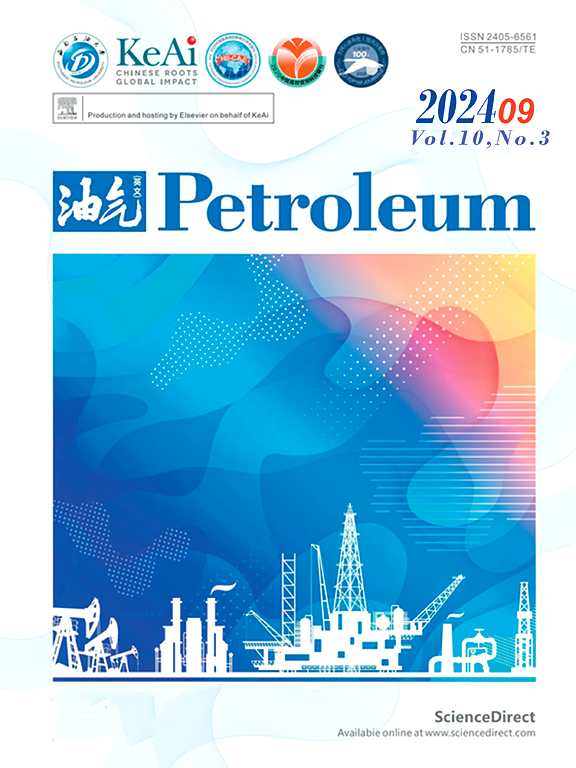压裂页岩储层压力耗竭引起的应力演变规律:对后续压裂和填充井开发的影响
IF 4.2
Q2 ENERGY & FUELS
引用次数: 0
摘要
经常观察到与油藏枯竭有关的应力变化。排水区域内部和周围的应力演化会对充填井的完井和重复压裂产生很大影响。为准确预测页岩气储层应力分布,基于Biot理论、嵌入离散裂缝模型和有限体积法,建立了考虑页岩气微观渗流机理和复杂天然裂缝分布的流体-流动/地质力学耦合模型。基于该模型,可以综合考虑页岩气的吸附、解吸、扩散、滑移等机理以及NFs的随机分布,对应力进行预测。结果表明:在应力演化过程中,在某一点会出现σxx、σyy、σxy、Δσ、α极值和应力反转区,且在不同位置出现极值的时间不同;确定这一规律的关键是孔隙压力梯度,孔隙压力梯度具有时空演化效应。不同微观渗流机制显著影响页岩气的储集和运移,导致储层压力和应力分布存在显著差异。初始应力差越大,应力逆转越困难。当初始应力差超过一定极限时,储层内不发生应力反转。在NFs分布差异的影响下,压力枯竭区的形状和压力梯度的大小存在显著差异。随着NFs接近角的增大,区域顶部和底部的应力反转范围逐渐减小;同时,裂缝附近最大水平应力(MHS)方向也逐渐减小。当裂缝接近角度相同时,天然裂缝数量对应力影响不大。由于NFs和水力裂缝的影响,应力各向异性增强,局部应力极值和应力反转区出现时间差异明显,充填井压裂和重复压裂的时机选择变得困难。该研究对于认识页岩气藏应力演化规律,指导完井和重复压裂设计具有重要意义。本文章由计算机程序翻译,如有差异,请以英文原文为准。
Evolution law of stress induced by pressure depletion in fractured shale reservoirs: Implications for subsequent refracturing and infill well development
Stress changes associated with reservoir depletion have been frequently observed. Stress evolution within and around the drainage areas can affect the completion of infill wells and refracturing considerably. To accurately predict the stress distribution in shale gas reservoirs, a coupled fluid-flow/geomechanics model considering the microscopic seepage mechanism of shale gas and the distribution of complex natural fractures (NFs) was derived based on Biot's theory, the embedded discrete fracture model, and the finite volume method. Based on this model, stress can be predicted by considering the mechanisms of adsorption, desorption, diffusion, and slippage of shale gas and the random distribution of NFs. The results show that in the process of stress evolution, there will be extremes of σxx, σyy, σxy, Δσ, α, and stress reversal area at a certain point, and the time of occurrence of extremes differs at different positions. The key to determining this law is the pore pressure gradient, with a spatiotemporal evolution effect. Different microscopic seepage mechanisms significantly influence the storage and transmission of shale gas, leading to significant differences in the distributions of reservoir pressure and stress. The larger the initial stress difference, the more difficult the stress reversal. When the initial stress difference exceeds a certain limit, stress reversal does not occur in the reservoir. Under the influence of the distribution difference of the NFs, the shape of the pressure-depletion area and magnitude of the pressure gradient differed significantly. As the approaching angle of NFs increased, the range of stress reversal in the top and bottom parts of the domain gradually decreases; At the same time, the orientation of maximum horizontal stress (MHS) near the fractures also gradually decreases. When the approaching angles of the NFs are the same, the number of natural fractures has little effect on the stress. Owing to the effect of NFs and hydraulic fracture, the anisotropy of stress is enhanced, the occurrence time of extreme value of local stress and stress reversal area differ significantly, and selecting the timing of infill well fracturing and refracturing becomes difficult. This research is essential to understanding the stress evolution law of shale gas reservoirs and guiding the completion of infill wells and refracturing design.
求助全文
通过发布文献求助,成功后即可免费获取论文全文。
去求助
来源期刊

Petroleum
Earth and Planetary Sciences-Geology
CiteScore
9.20
自引率
0.00%
发文量
76
审稿时长
124 days
期刊介绍:
Examples of appropriate topical areas that will be considered include the following: 1.comprehensive research on oil and gas reservoir (reservoir geology): -geological basis of oil and gas reservoirs -reservoir geochemistry -reservoir formation mechanism -reservoir identification methods and techniques 2.kinetics of oil and gas basins and analyses of potential oil and gas resources: -fine description factors of hydrocarbon accumulation -mechanism analysis on recovery and dynamic accumulation process -relationship between accumulation factors and the accumulation process -analysis of oil and gas potential resource 3.theories and methods for complex reservoir geophysical prospecting: -geophysical basis of deep geologic structures and background of hydrocarbon occurrence -geophysical prediction of deep and complex reservoirs -physical test analyses and numerical simulations of reservoir rocks -anisotropic medium seismic imaging theory and new technology for multiwave seismic exploration -o theories and methods for reservoir fluid geophysical identification and prediction 4.theories, methods, technology, and design for complex reservoir development: -reservoir percolation theory and application technology -field development theories and methods -theory and technology for enhancing recovery efficiency 5.working liquid for oil and gas wells and reservoir protection technology: -working chemicals and mechanics for oil and gas wells -reservoir protection technology 6.new techniques and technologies for oil and gas drilling and production: -under-balanced drilling/gas drilling -special-track well drilling -cementing and completion of oil and gas wells -engineering safety applications for oil and gas wells -new technology of fracture acidizing
 求助内容:
求助内容: 应助结果提醒方式:
应助结果提醒方式:


